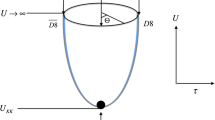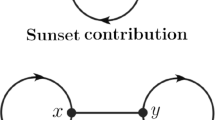Abstract
We propose a holographic model of baryon interactions based on non-supersymmetric \( {\text{D}}7 - \overline {{\text{D}}7} \) flavor branes embedded in the Klebanov-Strassler background. The baryons are D3-branes wrapping the S 3 of the conifold with M strings connecting the D3 and the flavor branes. Depending on the location of the latter there are two possibilities: the D3 either remains separate from the flavor branes or dissolves in them and becomes a flavor instanton. The leading order interaction between the baryons is a competition between the attraction and the repulsion due to the σ and ω mesons. The lightest 0++ particle σ is a pseudo-Goldstone boson associated with the spontaneous breaking of scale invariance. In a certain range of parameters it is parametrically lighter than any other massive state. As a result at large distances baryons attract each other. At short distances the potential admits a repulsive core due to an exchange of the ω vector meson. We discuss baryon coupling to glueballs, massive mesons and pions and point out the condition for the model to have a small binding energy.
Similar content being viewed by others
References
K.-Y. Kim and I. Zahed, Nucleon-nucleon potential from holography, JHEP 03 (2009) 131 [arXiv:0901.0012] [SPIRES].
K. Hashimoto, T. Sakai and S. Sugimoto, Nuclear force from string theory, Prog. Theor. Phys. 122 (2009) 427 [arXiv:0901.4449] [SPIRES].
V.S. Kaplunovsky and J. Sonnenschein, Searching for an attractive force in holographic nuclear physics, JHEP 05 (2011) 058 [arXiv:1003.2621] [SPIRES].
T. Sakai and S. Sugimoto, Low energy hadron physics in holographic QCD, Prog. Theor. Phys. 113 (2005) 843 [hep-th/0412141] [SPIRES].
S. Kuperstein and J. Sonnenschein, A new holographic model of chiral symmetry breaking, JHEP 09 (2008) 012 [arXiv:0807.2897] [SPIRES].
I.R. Klebanov and M.J. Strassler, Supergravity and a confining gauge theory: duality cascades and χ SB -resolution of naked singularities, JHEP 08 (2000) 052 [hep-th/0007191] [SPIRES].
M. Ihl, M.A.C. Torres, H. Boschi-Filho and C.A.B. Bayona, Scalar and vector mesons of flavor chiral symmetry breaking in the Klebanov-Strassler background, arXiv:1010.0993 [SPIRES].
M. Berg, M. Haack and W. Mueck, Bulk dynamics in confining gauge theories, Nucl. Phys. B 736 (2006) 82 [hep-th/0507285] [SPIRES].
M. Berg, M. Haack and W. Mueck, Glueballs vs. gluinoballs: fluctuation spectra in non-AdS/non-CFT, Nucl. Phys. B 789 (2008) 1 [hep-th/0612224] [SPIRES].
A. Dymarsky and D. Melnikov, Gravity multiplet on KS and BB backgrounds, JHEP 05 (2008) 035 [arXiv:0710.4517] [SPIRES].
I. Gordeli and D. Melnikov, On I-even singlet glueballs in the Klebanov-Strassler theory, arXiv:0912.5517 [SPIRES].
J.D. Walecka, A theory of highly condensed matter, Annals Phys. 83 (1974) 491 [SPIRES].
M. Krasnitz, A two point function in a cascading N = 1 gauge theory from supergravity, hep-th/0011179 [SPIRES].
M. Krasnitz, Correlation functions in a cascading N = 1 gauge theory from supergravity, JHEP 12 (2002) 048 [hep-th/0209163] [SPIRES].
M.K. Benna, A. Dymarsky, I.R. Klebanov and A. Solovyov, On normal modes of a warped throat, JHEP 06 (2008) 070 [arXiv:0712.4404] [SPIRES].
A. Dymarsky, D. Melnikov and A. Solovyov, I-odd sector of the Klebanov-Strassler theory, JHEP 05 (2009) 105 [arXiv:0810.5666] [SPIRES].
M. Bianchi and W. de Paula, On exact symmetries and massless vectors in holographic flows and other flux vacua, JHEP 04 (2010) 113 [arXiv:1003.2536] [SPIRES].
S.S. Pufu,I.R. Klebanov,T. Klose and J. Lin, Green’s functions and non-singlet glueballs on deformed conifolds, J. Phys. A 44 (2011) 055404 [arXiv:1009.2763] [SPIRES].
E. Witten, Anti-de Sitter space, thermal phase transition and confinement in gauge theories, Adv. Theor. Math. Phys. 2 (1998) 505 [hep-th/9803131] [SPIRES].
I.R. Klebanov and E. Witten, Superconformal field theory on threebranes at a Calabi-Yau singularity, Nucl. Phys. B 536 (1998) 199 [hep-th/9807080] [SPIRES].
A. Dymarsky, S. Kuperstein and J. Sonnenschein, Chiral symmetry breaking with non-SUSY D7-branes in ISD backgrounds, JHEP 08 (2009) 005 [arXiv:0904.0988] [SPIRES].
S. Kuperstein, Meson spectroscopy from holomorphic probes on the warped deformed conifold, JHEP 03 (2005) 014 [hep-th/0411097] [SPIRES].
A. Karch and E. Katz, Adding flavor to AdS/CFT, JHEP 06 (2002) 043 [hep-th/0205236] [SPIRES].
O. Mintakevich and J. Sonnenschein, On the spectra of scalar mesons from HQCD models, JHEP 08 (2008) 082 [arXiv:0806.0152] [SPIRES].
E. Witten, Baryons and branes in Anti de Sitter space, JHEP 07 (1998) 006 [hep-th/9805112] [SPIRES].
D.J. Gross and H. Ooguri, Aspects of large-N gauge theory dynamics as seen by string theory, Phys. Rev. D 58 (1998) 106002 [hep-th/9805129] [SPIRES].
A. Brandhuber, N. Itzhaki, J. Sonnenschein and S. Yankielowicz, Baryons from supergravity, JHEP 07 (1998) 020 [hep-th/9806158] [SPIRES].
C.G. CallanJr.,A. Guijosa,K.G. Savvidy and O. Tafjord, Baryons and flux tubes in confining gauge theories from brane actions, Nucl. Phys. B 555 (1999) 183 [hep-th/9902197] [SPIRES].
D.K. Hong, M. Rho, H.-U. Yee and P. Yi, Dynamics of baryons from string theory and vector dominance, JHEP 09 (2007) 063 [arXiv:0705.2632] [SPIRES].
O. Bergman, G. Lifschytz and M. Lippert, Holographic nuclear physics, JHEP 11 (2007) 056 [arXiv:0708.0326] [SPIRES].
S. Seki and J. Sonnenschein, Comments on baryons in holographic QCD, JHEP 01 (2009) 053 [arXiv:0810.1633] [SPIRES].
C.P. Herzog, I.R. Klebanov and P. Ouyang, Remarks on the warped deformed conifold, hep-th/0108101 [SPIRES].
E. Witten, Baryons in the 1/n expansion, Nucl. Phys. B 160 (1979) 57 [SPIRES].
E. Witten, σ-models and the ADHM construction of instantons, J. Geom. Phys. 15 (1995) 215 [hep-th/9410052] [SPIRES].
M.R. Douglas, Branes within branes, hep-th/9512077 [SPIRES].
M.R. Douglas, Gauge fields and D-branes, J. Geom. Phys. 28 (1998) 255 [hep-th/9604198] [SPIRES].
H. Hata, T. Sakai, S. Sugimoto and S. Yamato, Baryons from instantons in holographic QCD, Prog. Theor. Phys. 117 (2007) 1157 [hep-th/0701280] [SPIRES].
O. Aharony, A note on the holographic interpretation of string theory backgrounds with varying flux, JHEP 03 (2001) 012 [hep-th/0101013] [SPIRES].
S.S. Gubser, C.P. Herzog and I.R. Klebanov, Symmetry breaking and axionic strings in the warped deformed conifold, JHEP 09 (2004) 036 [hep-th/0405282] [SPIRES].
S.S. Gubser, C.P. Herzog and I.R. Klebanov, Variations on the warped deformed conifold, Comptes Rendus Physique 5 (2004) 1031 [hep-th/0409186] [SPIRES].
K. Hashimoto, T. Sakai and S. Sugimoto, Holographic baryons: static properties and form factors from gauge/string duality, Prog. Theor. Phys. 120 (2008) 1093 [arXiv:0806.3122] [SPIRES].
M.K. Banerjee, T.D. Cohen and B.A. Gelman, The nucleon nucleon interaction and large-N c QCD, Phys. Rev. C 65 (2002) 034011 [hep-ph/0109274] [SPIRES].
A. Cherman, T.D. Cohen and M. Nielsen, Model independent tests of skyrmions and their holographic cousins, Phys. Rev. Lett. 103 (2009) 022001 [arXiv:0903.2662] [SPIRES].
H. Ooguri and C.-S. Park, Spatially modulated phase in holographic quark-gluon plasma, Phys. Rev. Lett. 106 (2011) 061601 [arXiv:1011.4144] [SPIRES].
Author information
Authors and Affiliations
Corresponding author
Additional information
ArXiv ePrint: 1012.1616
Rights and permissions
About this article
Cite this article
Dymarsky, A., Melnikov, D. & Sonnenschein, J. Attractive holographic baryons. J. High Energ. Phys. 2011, 145 (2011). https://doi.org/10.1007/JHEP06(2011)145
Received:
Accepted:
Published:
DOI: https://doi.org/10.1007/JHEP06(2011)145




